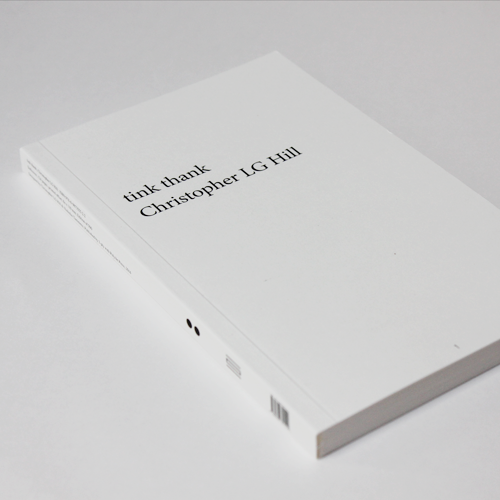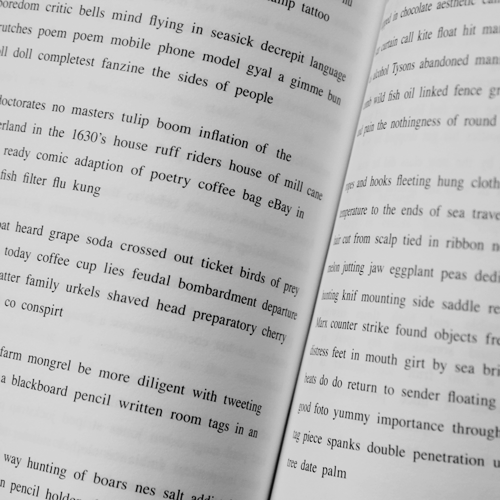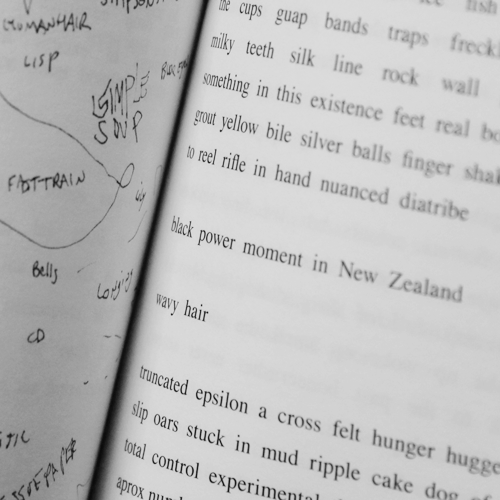03
Christopher L G Hill
tink thank
Softcover, 124pp, 110 x 180 mm, offset
Edition of 500
Design by Nicholas Tammens and Christopher L G Hill
Published by 3-ply and Poly:be Press, 2014
ISBN 978-0-9873555-2-2
RRP AUD22.00
Since 2011, Christopher L G Hill has sustained an open-ended project of twitter poetry. Through fluid yet disciplined haiku-like tweets, a multistanza poem has emerged, described on twitter.com/CLGHill as “a florid poem flailing in reflexivity”. In his artist book tink thank, Christopher L G Hill has translated poetic material crafted according to internet protocols into a form that operates in a non-virtual, printed environment. The result is not an analogue duplication; through addition, subtraction and reformatting of the original poetic content, a new work has been produced that explores the lived nature of expression, impression and introspection.
Text within and outside of an internet context has become an integral part of Christopher L G Hill’s expansive practice over the past decade, see for example: anotheryouapictureavoicemessagemime.blogspot.com.au
Launched @ SLOPES, Melbourne, Australia on 22 May 2014. Alex Selenitsch spoke about words, Justin Clemens read Et en es… and palindromic poetry, and Christopher L G Hill presented a reading from tink thank.
Launched @ MONOGRAPH BOOKWERKS, Portland, OR, USA on 29 May 2014. Lisa Radon read from Prototyping Eutopias, Morgan Ritter performed a selection of poetry, tink thank was presented by Nicholas Tammens, and Will Luers introduced Poly:be Press.
ALEX SELENITSCH: “ON WORDS”
“When I talk as I’m doing now, and in this instance reading at the same time, the only breaks in the sound are when I take a breath. The garble in between the breaths is made up of individual words but you have to know them to recognise them, otherwise it’s a long melismatic sound event. Remember that jibe about ‘your funny joined up writing’ in Eric the Red? Well, for just about any language its your funny joined-up speaking.
It used to be just joined up letters, but some time ago, we began using a little space to group the letters into individual words. Like zero, which doesn’t exist (but has a word for it be evident), the invention of that little space between words in a line has had an enormous effect. The little space, which is recognized in twitter as a character, has functioned as unrelenting propaganda for the idea that language consists of discreet lumps.
A word is one of those lumps. A word is a compression of different letters. Like a cube of Darrell Lea liquorice all-sort with its toxic coloured layers, a word glues together unrelated signs to signify something other than its parts. These unrelated signs, that is, the letters, have very little semantic charge, often none at all, but in combination they light up. Of course, it’s possible to have a language with no words in it at all. Any non-alphabetic language will do as an example. But here, in this room (which is a four letter word) we can’t do what I’m doing through hieroglyphs, or brushed characters and their smudgy relatives. In any case, it would only come out as funny joined up speaking.
Most of us treat words as if they were jigsaw pieces intended for a realistic picture called grammar, that is, they are only allowed to be put together in certain ways. Although there is the ever-present example of the dictionary where words are assembled for inspection according to a completely arbitrary sequence: that shadow chain gang called the alphabet.
Talking of this, I’m reminded of Mike Parr’s Wall Definition. In this work from the 1970s, when Parr seemed to be doing nothing but typing 24hours a day, and with one arm (!), he typed out the dictionary definition of the word ‘wall’, then followed this with the dictionary definition of each word in that original definition, in sequence. It took 254 pages of close typing. It’s a word masterpiece, and – I can vouch for it – a good read. I particularly liked it because there was no grammar, no narrative, no character development, yet lots of data and oblique cultural connections.
A word is an island which grammar links into archipelagos. Or it could be a boat which can group with other boats, especially when they are linked to form a bridge over water. But neither of these images gets it quite right: words come from very different histories, different languages, different experiences and so on. Any sentence is a heterogeneous train dragged along by steam, diesel or electricity. Maybe that sentence should end as ‘dragged along by T.S. Eliot, Wallace Stevens or Allen Ginsberg’. All of these were writers of sentences, and only occasionally pointed to the landscape they dragged their words through. Whereas I am interested in writers who chart and make explicit the language they travel in.
Just before, I suggested that the word is a lump in language. But between the single word and the sentence, between the single carriage and the train, there are phrases, often three words long, which trick the words into accepting grammar. There is a long scalar spectrum of lumps going from letter to word, to phrase, to sentence, to paragraph, to chapter, to essay, to novel, and maybe even further. At each step, there is a bigger lump, but each lump is conceived of as a single entity, to enable it to be held with the minimum of attention and concentration. So sometimes a writer will leave out the intermediate lumps to frighten us into reconsidering the language, to question the arbitrary acceptance of conventions and enjoy the new territory. Finnegan’s Wake does this: in your hands, it’s a novel, but for its reading, the book is a broken train of wordy lumps that clamp together other words. Instead of making words with letters, Joyce makes them with other words, lump by lump.
What this points to, is that this zone, either side of the word (the letter and the phrase) is a great playpen. I know this, because I’ve spent much of my adult life playing in the space between single letters and single words, and I read lots of literature which roams the vast landscape between the single word and the phrase. The experience of seeing language anew and wondrous has put me off novels and longer epics, except for such texts as Parr’s Wall Definition I mentioned before. And it explains why I’m so pleased to see and read and hear the kind of word play that tink thank sets out for us. If there is a word for it, I think it’s thanks. I tink so. I tink so and so. Thanks for listening. Here’s the tink: (rings bell)."




